#XVth century
Explore tagged Tumblr posts
Text
The Melun Diptych, Jean Fouquet c. 1420–1481
El Díptico de Melun, Jean Fouquet c. 1420–1481
Il Dittico di Melun, Jean Fouquet c. 1420–1481
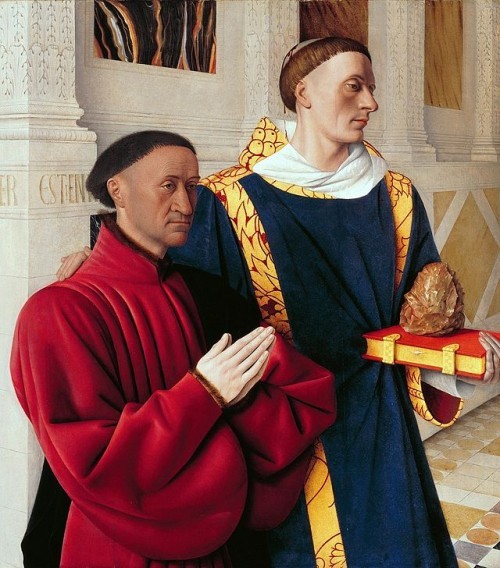
On the left, Étienne Chevalier with Santo Stefano (Berlino, Staatliche Museen Preussischer Kulturbesitz)
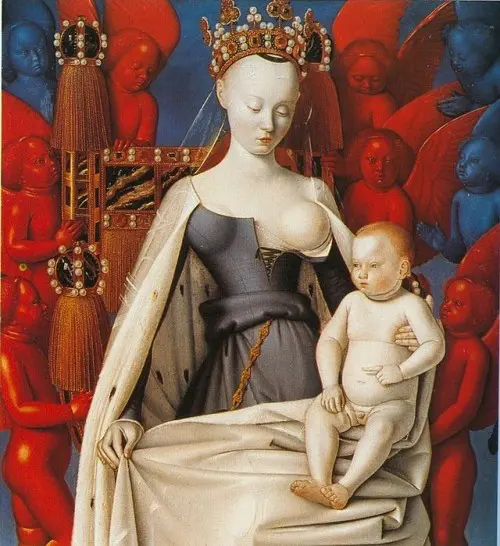
On the right, Virgin with Child and Angels (Anversa, Musée Royal des Beaux Arts).
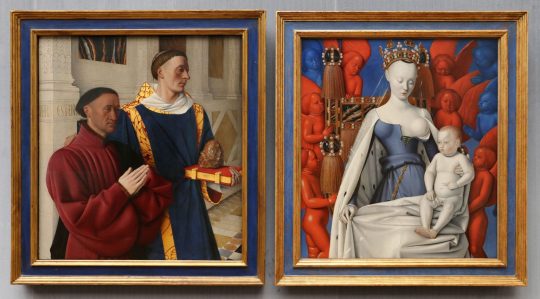
Jean Fouquet, Melun’s diptych reassembled.
(English / Español / Italiano)
The well-known Diptych of Melun or Diptych of the Virgin and Child with Angels is a 15th-century work by one of France's foremost artists, Jean Fouquet. The work is presented on two small panels painted in oil on wood, just over ninety centimetres high and eighty-five centimetres wide, which were separated during the French Revolution and remain so today. One of the panels, that of the Virgin, is in the Royal Museum of Fine Arts in Antwerp, while the other is in the Gëmaldegalerie in Berlin.
The work was commissioned by one of the most powerful men at the court of King Charles VII of France, Étienne Chevalier, to decorate the funeral chapel of Agnes Sorel. Agnes Sorel has gone down in history as the first recognised mistress of a monarch, her beauty was said to be unparalleled and she was nicknamed the Lady of Beauty. It seems that the young lady was an inspiration to many artists of the time, in fact, according to legend, the Virgin of Fouquet is the portrait of the lady. Be that as it may, what is certain is that the artist has depicted a work with a highly erotic and sensual charge, perhaps because she was the king's mistress, or perhaps because legend has it that Agnes Sorel was also Chevalier's companion, who later became his executor.
Fouquet is one of the most outstanding artists of the early Renaissance outside Italy. His work maintains the Gothic tradition while incorporating Renaissance elements influenced by artists such as Piero della Francesca as a result of his travels in Italy and the detail of Flemish painting.
source: arte.laguia2000.com
------------------------------------------------------------------------------
El conocido Díptico de Melun o Díptico de la Virgen con Niño y ángeles es una obra del siglo XV realizada por uno de los artistas más destacados de todo Francia, Jean Fouquet. La obra se presenta en dos pequeñas tablas pintadas en óleo sobre madera de poco más de noventa centímetros de altura y ochenta y cinco de anchura que fueron separadas en la Revolución francesa y en la actualidad siguen así, una de las tablas, la de la Virgen, se encuentra en el Real Museo de Bellas Artes de Amberes mientras que su compañera permanece resguardada en la Gëmaldegalerie de Berlín.
La obra fue encargada por uno de los hombres más poderosos en la corte del rey Carlos VII de Francia, Étienne Chevalier, para adornar la capilla funeraria de Agnes Sorel. Agnes Sorel ha pasado a la historia por ser la primera amante reconocida de un monarca, de ella se decía que su belleza no tenía parangón y fue apodada como la Dama de la Belleza. Parece ser que la joven dama sirvió de inspiración a numerosos artistas de la época, de hecho según cuenta la leyenda la Virgen de Fouquet es el retrato de la dama. Sea como fuere, lo cierto es que el artista ha representado una obra con una gran carga erótica y sensual quizás por tratarse de la amante del rey o quizás porque la misma leyenda cuenta que Agnes Sorel también fue compañera de Chevalier quién después de esto se convirtió en su albacea testamentario.
Fouquet es uno de los artistas más destacados del primer renacimiento fuera de las fronteras italianas. Su obra mantiene la tradición goticista a la vez que incorpora elementos renacentistas con influencias de artistas como Piero della Francesca fruto de sus viajes a Italia o el detallismo de la pintura flamenca.
fuente: arte.laguia2000.com
------------------------------------------------------------------------------
Il famoso Dittico di Melun o Dittico della Madonna con Bambino e Angeli è un'opera del XV secolo realizzata da uno degli artisti più importanti di tutta la Francia, Jean Fouquet. L'opera è presentata in due piccole tavole dipinte ad olio su legno di poco più di novanta centimetri di altezza e ottantacinque di larghezza che sono state separate nella Rivoluzione francese e oggi seguono così, una delle tavole, quella della Madonna, si trova nel Museo Reale di Belle Arti di Anversa, mentre la sua compagna è custodita nella Gëmaldegalerie di Berlino.
L'opera fu commissionata da uno degli uomini più potenti alla corte del re Carlo VII di Francia, Étienne Chevalier, per adornare la cappella funeraria di Agnes Sorel. Agnes Sorel è passata alla storia come la prima amante riconosciuta di un monarca, di cui si diceva che la sua bellezza non avesse pari e fu soprannominata la Dama della Bellezza. Sembra che la giovane donna abbia ispirato numerosi artisti dell'epoca, infatti secondo la leggenda la Vergine di Fouquet è il ritratto della signora. Sia come sia, la verità è che l'artista ha rappresentato un'opera con una grande carica erotica e sensuale forse perché si tratta dell'amante del re o forse perché la stessa leggenda racconta che Agnes Sorel fu anche compagna di Chevalier che dopo questo divenne il suo esecutore testamentario.
Fouquet è uno degli artisti più importanti del primo rinascimento fuori dai confini italiani. La sua opera conserva la tradizione gotica, incorporando elementi rinascimentali con influenze di artisti come Piero della Francesca frutto dei suoi viaggi in Italia o il dettaglio della pittura fiamminga.
fonte: arte.laguia2000.com
#il quattrocento#middle ages#edad media#XVth century#Jean Fouquet#díptico de melun#dittico di melun#diptych of melun#gothic tradition#renaissance#gotico#rinascimento#pintura flamenca#pittura fiamminga#Flemish painting
1 note
·
View note
Text
ew fucked me in the head because I find myself thinking stuff like in the end Florence's literature became heavy with history just as much as the city of Rome with the way the whole of Italy took it as a model, it must be full of slow and ancient spirits there
10 notes
·
View notes
Text
I was recommended As Above So Below because it's apparently a fun creepy horror movie set in an original location (Paris catacombs) but I didn't know that it's not a movie for a history buff. I'm 10 min in and so far I've mainly been laughing and saying: "What?" through an awkward smile a lot
#Nicholas Flamel physically made his own tombstone???#Like literally carved the fucking thing#Girl what???#'he was widely known as an alchemist who managed to create the philosophy stone'#Yeah in like renaissance times when the whole philosophers stone bullshit really picked up#This movie is so unseriouz#Girl how did a french guy from the xvth century paris used sumerian code key written on an ancient statue in some cave in iran to make what
36 notes
·
View notes
Text



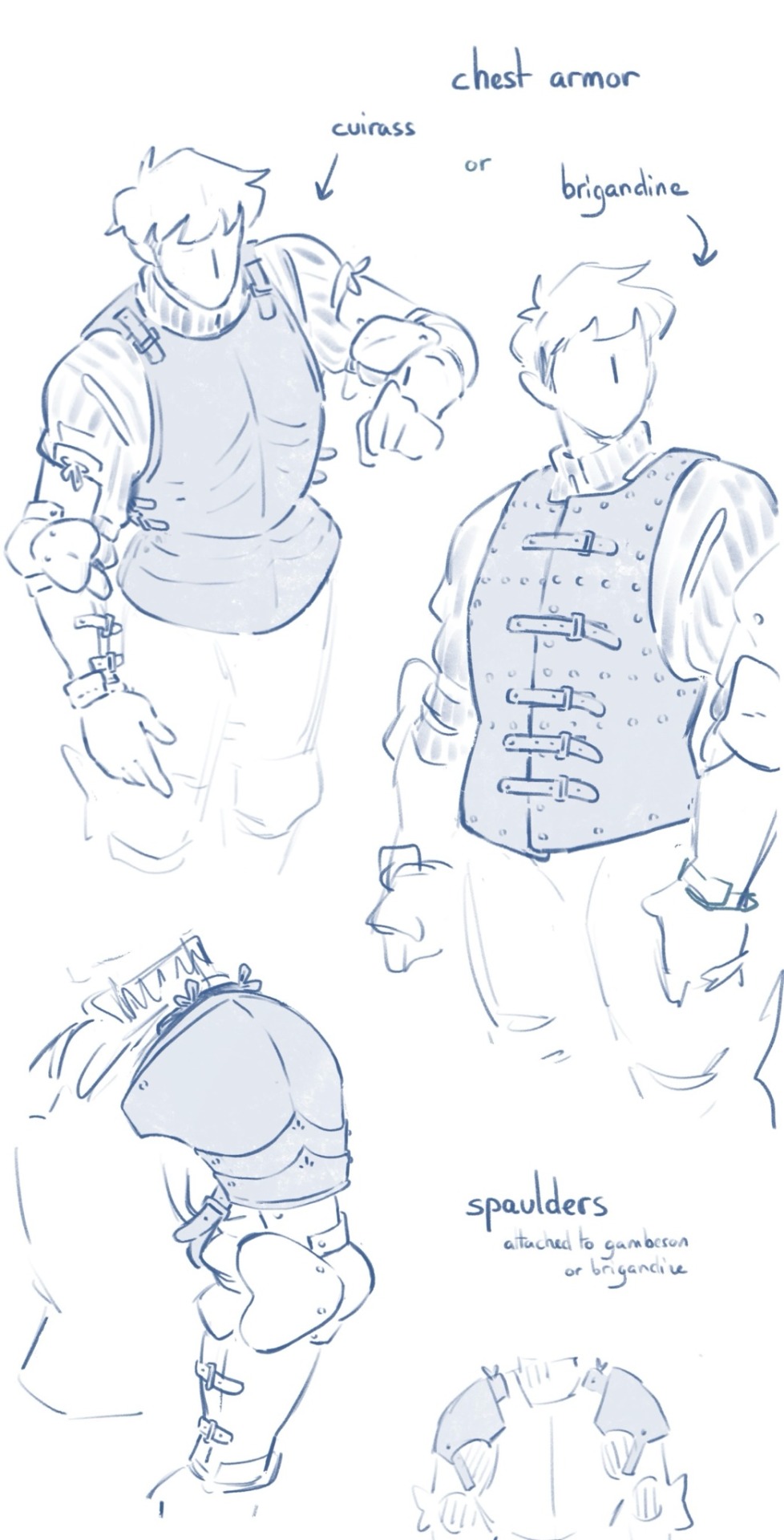
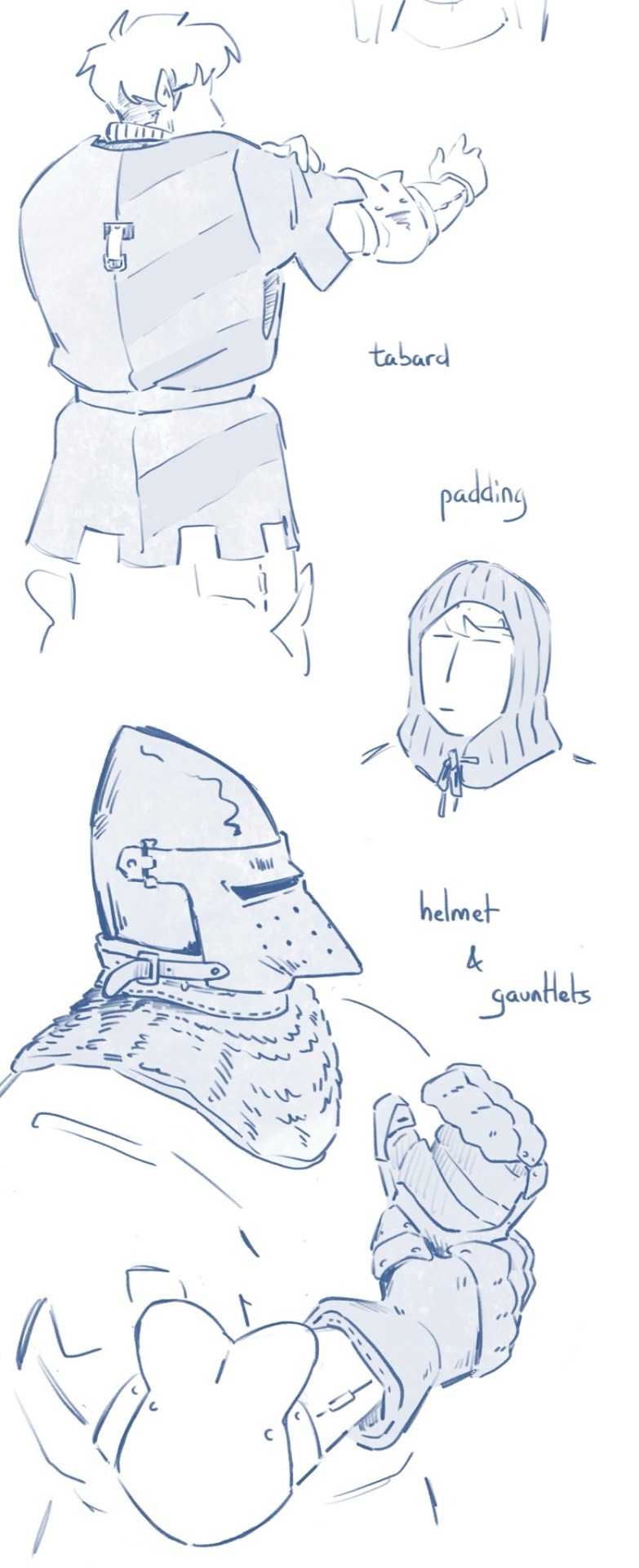
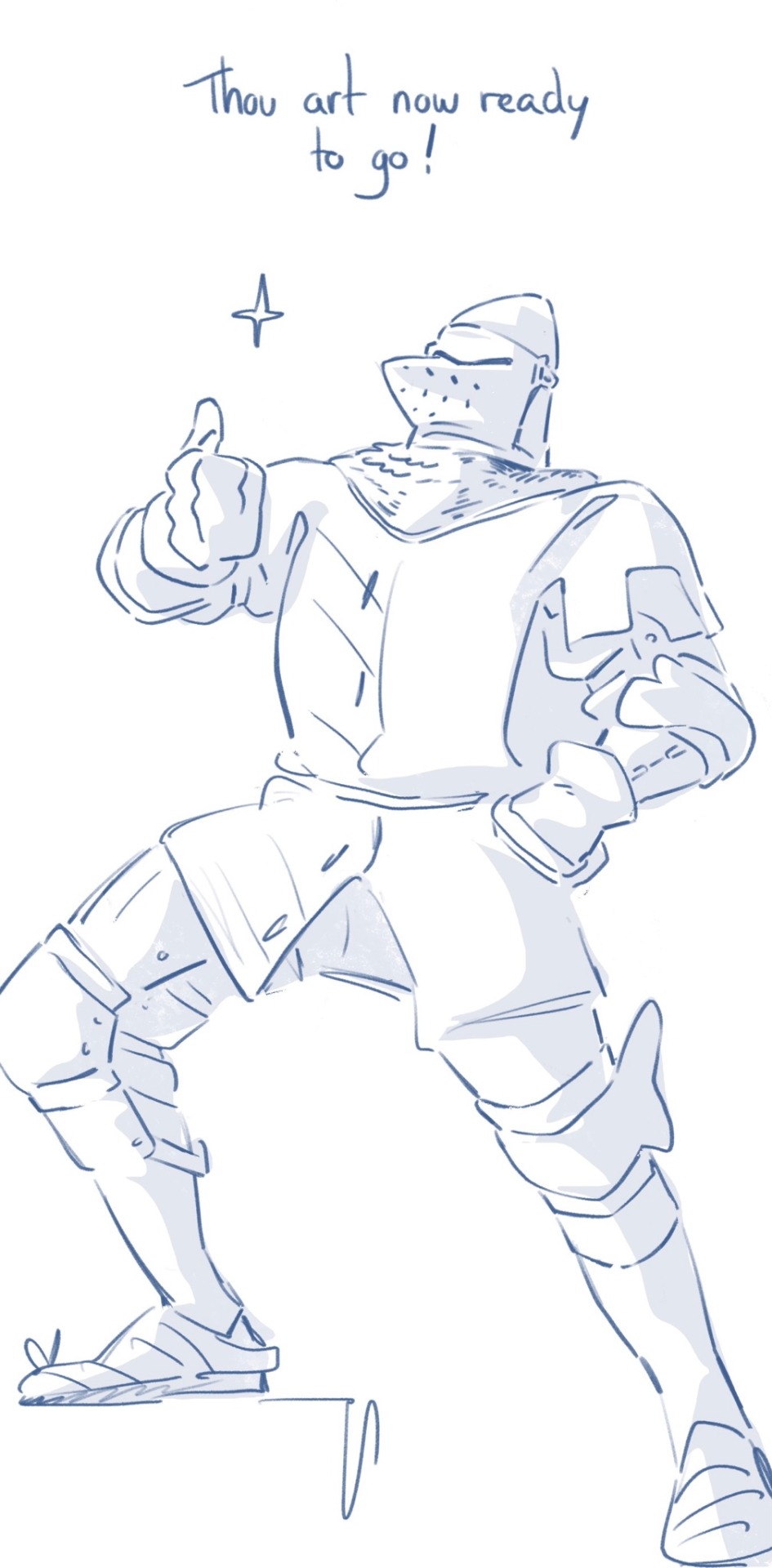
Please be mindful that i didn't draw any chainmail underneath, first bc im lazy, but every armor from XV century had some : over the gambeson, under the plate, fully or on located areas. They also used pants gambesons.
Also this is just one example, XVth had so much armor variations for any of the parts above
Here're some references i like to use :
-> The Evolution of Knightly Armour
-> Age of Craft
-> ArmaFora catalogue
#thanks for coming to my ted talk#and don't you dare go hollow#armor#middle age#helmet#medieval armor#buhurt#knight#mine#also i own an armor. yea i know how cool is that
913 notes
·
View notes
Note
i am SOOOO interested in all of your Massà posts!! the twin princess (and of course gay monastery shenanigans) has really caught my eye!!! do you have any lore you’re willing to share? id be so excited to hear >_<
Hello ! Thanks a lot for your interest !
Massà is the setting for the big graphic novel I've signed about a year ago. I'm working on it side by side with my character design gigs and since it's a 200-or-so pages long beast I'm sorry to say it'll be a while before you guys can get an actual look at the story ! But I've been posting tidbits on my insta here and there.
The world it's set in is a low-ish fantasy alternate of XVth century Provence. The twins are called Sàvi and Sefia, and Sefia is married to a guy from the ruling family of the neighbour realm of Longitania (aka cursed Long France) That's guy number two below. would have loved niche subreddits and making spreadsheets if that was available to him
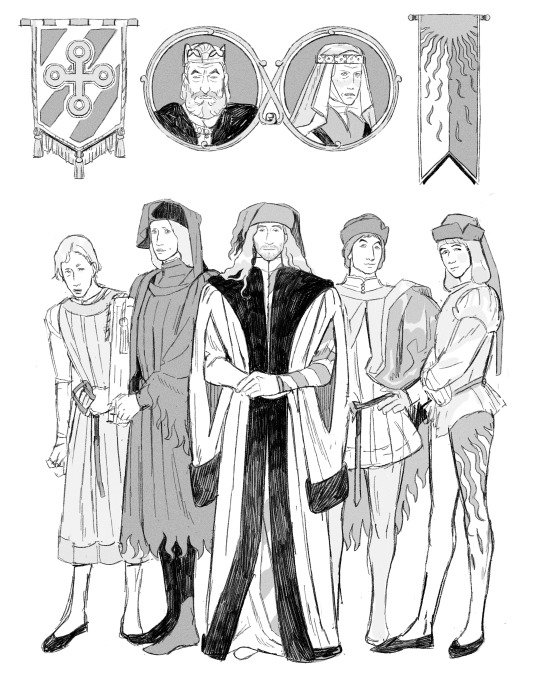
Since most of the intrigue takes place in the monastery the Longitans and Twin Princes intervene only in a handful of scenes so this is mostly lore for the sake of lore but here are some snippets of them and their delegation from the rough pages !


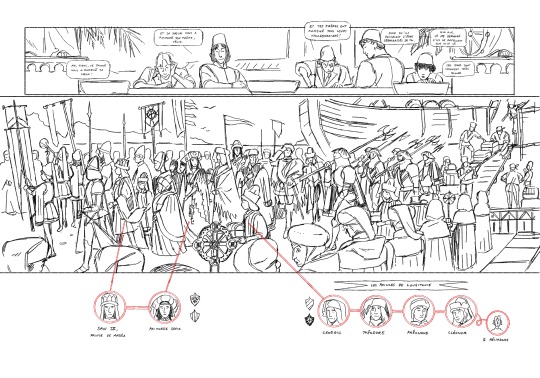
and a bonus wip panel for an extra display of artistry (pov : you've just called the prince a cockroach in front of all the Longitan ambassadors)

568 notes
·
View notes
Text


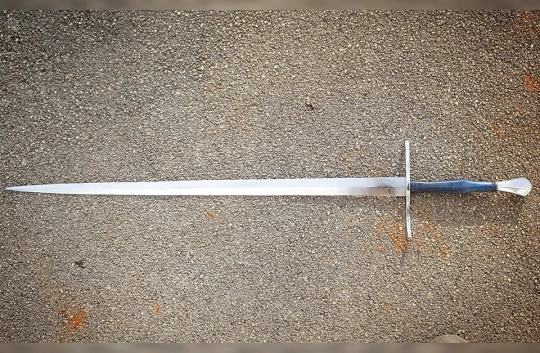


A Longsword, in a late XVth century German fashion.
Not a copy of a specific sword, but something that goes along with the style of such swords. Spring steel blade, mild steel cross and pommel, and leather over linen cord over wood grip. All hand-made, naturally.
Overall length 1209 mm, with a 945 mm blade (43 mm wide/6.14 mm thick at its base). Crossguard span is shy of 22 cm.
Weight is 1163 grams, with a point of balance 15 cm down the blade from the cross, giving this rather light sword some nice authority in the cut and the bind.
As always, more pics in the comments.
Yours for two thousand units of the Old World currency.
Can be given as scabbard for a few credits more.
237 notes
·
View notes
Text

asile!AU: Carmilla Carmine, noblewoman, fighter, exorcist
° wife of wealthy Burgundian nobleman who lived in XVth century
° named after Our Lady of Carmel
° as a young girl, she dreamed of swinging a sword and practiced secretly
° one day Carmilla cut her face badly, after which father forbade her to use a sword and soon found her husband
° servants respected her very much
° Odette is her own daughter; Clara is husband's daughter by a Moorish woman
° he wasn't going to recognize her, but Carmilla took girl to the castle, christened her and raised with own baby together
° died in the Burgundian Wars (1474-1477 AD); husband died on the battlefield, Carmilla stayed in the castle with all men and women and even took command of the defenses, but unfortunately their castle has been overrun
° when Carmilla realized they had lost the battle, she performed a mercy killing on young daughters to keep them from being captured and raped, and then killed herself too
° went to Heaven, all together, where Carmilla was an exorcist
° after a few centuries she became too cruel and bloodthirsty towards victims, for which she was soon exiled to the underworld
° Odette and Clara objected to this decision and left with her
77 notes
·
View notes
Text
I can't find any information on the Slovak printing press in the XVth century..
18 notes
·
View notes
Text
I have a fic idea but I'm illiterate
Hannibal is immortal and in some XVth century was a painter, who either had a model who looked like Will or maybe he saw his face in a dream or something like that. And Will sees himself in paintings when in a museum or when in Uffizi before meeting with Hannibal
84 notes
·
View notes
Photo


Ruins of the XVth century castle in Holhory, Lviv Region, early XXth century
82 notes
·
View notes
Text


Concept art I made for all Ruby Dungeon's armors.
I made a nifty bit of coding so balanced stats (defense, weight and price) are automatically generated for each armor piece just according to it's weight-class (heavy, medium or light) and level.
So then, I noted what the generated stats were for each intended armor and designed accordingly what kind of armor would fit those types of stat (like, what a 3kg helmet that protect very well for cheap would look like for exemple).
I also tryed to keep stuff that corresponded to their time-period, taking mainly inspiration from the XVth century, or older for the cheaper stuff.
#art#artists on tumblr#my art#drawing#trans artist#queer artist#fantasy#sketch#sketches#traditional art#doodle#sketchbook#concept art#design#character sheet#character design#character art#sketching#fantasy rpg#fantasy art#medieval fantasy#medieval#15th century#armor#knight#middle ages#pencil drawing#turn based rpg#rpg#gamedev
4 notes
·
View notes
Text
Wait. So. I'm a history student, and right now, we're in modern history and talking about Christopher Columbus. Who wanted to go to India, by boat. How did he want to do that ?
Right. Travel around the Earth. Because Earth is round. And they knew that at the end of the XVth century.
Now. Explain to me, how the hell do people think the Earth is FLAT ??????
Like, If you believe that, I'm sorry dude, but you're dumber than an XVth century man (yes, many of them knew. I don't actually believe people thought the Earth was flat at that time. How did we end up thinking that again ? Like we knew it was round during Antiquity, through middle age -yeah, they didn't believe in heliocentrism, but the Earth was not flat- and now what ? I don't understand.)
#conspiracy theories#flat earth#christopher columbus#history#modern history#like seriously#who thought of that ?#who got that idea ?#and who would be dumb enough to belive it ?#colonialism#i guess ?#I mean I'm talking about it a bit I guess?
2 notes
·
View notes
Text
🍋 Lemon Tree Hotels Expands Again: New Darjeeling Property and a Year of Steady Growth

Lemon Tree Hotels Limited (LTHL), India’s leading mid-market hospitality chain, has just signed a new property in Darjeeling, West Bengal. The 65-room hotel under the Keys Prima brand is the latest addition in a string of signings that reflect the company’s bullish stance on asset-light expansion across India.
📍 A Fresh Address in Darjeeling
The new hotel, set to open in FY 2026, will be managed by Lemon Tree’s wholly owned subsidiary, Carnation Hotels Private Limited. It will feature 65 rooms, a restaurant, a meeting room, and public spaces for leisure and corporate travelers. Located close to the Darjeeling railway station and with road access to Bagdogra Airport, it’s positioned for high visibility and accessibility.
🏨 Lemon Tree’s Pipeline: What’s Been Signed Recently?
🕒 In the Last 3 Months:
Estimated 3 to 4 hotel signings, including:
📅 In the Last 1 Year:
Lemon Tree’s portfolio has grown from ~180 to over 210 hotels (including pipeline properties).
That means the company signed at least 30 new properties in the past year, most under management or franchise agreements.
The company continues to focus on high-demand micro-markets across India, especially in leisure and religious circuits.
💼 Revenue and Profit Impact: Crunching the Numbers
Lemon Tree’s strategy revolves around managed/franchised hotels, which means it doesn’t own the real estate but earns a management fee (typically 8–12% of total revenue) from each hotel.
📈 For the Darjeeling Property:
Expected Annual Revenue (hotel level): ₹6–7.5 crore
Estimated Fee Income for Lemon Tree: ₹50–90 lakhs/year
Revenue starts from FY 2027 (after the hotel opens in FY26)
🏨 Impact from All Acquisitions in Last 12 Months:
30 new properties × average 60–80 rooms
Estimated aggregate annual revenue (hotel level): ₹450–550 crore
Lemon Tree’s potential fee income: ₹35–50 crore annually once all hotels are operational
These properties are expected to go live in staggered timelines over FY26–FY28
This marks a significant boost to recurring income with minimal capital investment, improving both margins and return on capital employed (ROCE).
🔍 Strategic Outlook
Lemon Tree’s multi-brand portfolio includes:
Aurika Hotels & Resorts (Luxury)
Lemon Tree Premier (Upper Midscale)
Red Fox Hotels (Economy)
Keys Prima, Select & Lite (Midscale to Budget)
By leveraging its asset-light model, Lemon Tree continues to deepen its presence across India and abroad (Dubai, Bhutan, Nepal), reduce risk, and strengthen profitability.
💬 Final Word
The Darjeeling hotel is more than just a scenic location; it's a testament to Lemon Tree’s disciplined, data-driven expansion. With 30+ new hotels added to its pipeline in a year and a clear path to increased fee-based revenue, Lemon Tree Hotels is not just growing — it's growing smart.
📢Disclaimer: This information is for educational purposes only and should not be considered investment advice. Please do your own research before making any financial decisions
Enjoyed this post? Like, Comment & Follow my blog for more insightful content!
youtube
Source: 🍋 Lemon Tree Hotels Expands Again: New Darjeeling Property and a Year of Steady Growth
0 notes
Text

Bembo-Visconti-tarot-arcanum-10-wheel of fortune.jpg
Summaryedit
Description
English: A major arcana card in Visconti Sforza tarot deck, beautifully drawn in the mid XVth century by Italian artist Bonifacio Bembo for the Visconti and Sforza dukes of Milan. Four cards (out of seventy-eight) are lost from the deck (the fifteenth and sixteenth major arcana—respectively the Devil and the Tower—, the Knight of Coins, and the Three of Swords), thus seventy-four cards remain.Datemid XVth centurySourceThe card images were scanned by David Madore and published on the internet in 2003-09. They are scans of a fac simile version printed by AGMüller in Switzerland, though US Games Systems also seems to be somehow part of the editing process, which David bought in 2003-08 from an online store (broken link).AuthorBonifacio Bembo (1420–1480) Alternative names
Bembo, BonifazioDescriptionItalian painter and illuminatorDate of birth/death1420 after 1477Location of birth/deathBresciaMilanWork period1447–1477Work location
Milan
11 notes
·
View notes
Note
How to evaluate Annette Carson's defense of Richard III? I feel like she clearly took her fantasies seriously
I know her, even though I haven't read much of her work considering that I don't wanna pay for it. Her work I'm most familiar with is Richard Duke of Gloucester as Lord Protector and High Constable of England.
I heard that she claims to not be Manichean about Richard III but her analysis of Richard as Constable and Lord Protector shows otherwise. Basically, she argues that Richard holding those two offices means that his killing of Hastings was legal and in the norms of the times (by extension it means Richard can execute whoever the hell he wants). It encapsulates everything wrong with certain defences of Richard III, an utter ignorance of late medieval norms and England's norms. Richard wasn't pursuing a classic legal framework that day and he knew that considering Hastings was either executed without trial or after a private and hasty one. Also, Hastings' execution wasn't normal considering how much contemporaries and posterity reacted to it. Finally, the trial of a peer generally necessitates a jury of his peers and except Howard and Buckingham, he didn't have that.
I just read some interviews of her to answer your question, and she hammers down the fact that Richard had been smeared as if it wasn't a well-known fact from historians to the general public. Richard had been subject to negative propaganda but Henry VII and every XVth century king. He had more defenders than most of them and there are people from this period whose defenders are almost non-existent (like Buckingham or Clarence).
So to me, she's another Ricardian whose objective is a rehabilitation campaign attempting to salvage his reputation, at the detriment of historical accuracy. I'll concede that her other works could be more even-handed but I doubt it. Her focus on Tudor propaganda is a diversion from the fact that Richard III became heavily unpopular during his reign because people had a very negative judgment of him. Henry VII mostly took what so many people thought of him in official records.
5 notes
·
View notes
Text




A Light Longsword, late XVth century
Inspired by various examples - especially those swords I saw during my latest visit at the @museearmee_invalides - and by the numerous effigies of the late 1400s from the Holy Roman Empire, more specifically this very specific type of grip with saltire-shaped risers and a leather flap over the middle of the cross.
Spring steel blade, heat-greyed fittings, grip is leather over wood with linen thread risers.
It is on the smaller end for such swords, but still rather powerful.
1140 mm long, blade is 906 mm, cross is 213 mm, and weight is a mere 927 grams still with a lot of punch. Point of balance is 12 cm from the cross.
Blade starts short of 6 mm thick, tapers gradually and then thickens a bit at the reinforced point, as should be.
I'm offering it for two thousand units of European money, adding six hundred for a scabbard.
72 notes
·
View notes
Text

1- El Hombre de Neuversen, también conocido como "Franz el Pelirrojo" aunque originalmente fuera rubio. Edad de Hierro (Alemania)
The Neuversen Man, also known as "Franz the Redhead" though originally blond. Iron Age (Germany)

2- Momia bebé de Qilakitsoq, S XV, Dinamarca. Se especula que el pequeño inuit fue depositado aún vivo sobre el cuerpo de su madre.
Baby mummy from Qilakitsoq, XVth century, Denmark. It is speculated that the little Inuit was deposited still alive on his mother’s body.

3- El Hombre de Tollund, Edad de Hierro prerromana, Dinamarca. Cuando fue descubierto aún conservaba la cuerda de tripa con la que fue estrangulado.
The Tollund Man, pre-Roman Iron Age, Denmark. When it was discovered it still retained the gut rope with which it was strangled.

4- Lady Dai, Dinastía Han (S II A.C.), China. No, que sepamos no guarda ningún parentesco con Kim Jong-un.
Lady Dai, Han Dynasty (2nd century BC), China. No, as far as we can tell, she bears no relation to Kim Jong-un.
MAS DE MOMIAS
Contemplar la cara de una momia siempre produce cierto desasosiego a quienes no están muy relacionados con la Arqueología (a quienes lo estamos, también) y hoy os traemos algunas que teniendo gran importancia arqueológica no sean quizás tan conocidas como Ötzi o las momias egipcias o precolombinas. También os indicamos el "nombre", la procedencia y la antigüedad para que podáis googlear más info de aquella que os interese.
MORE ABOUT MUMMIES
To contemplate the face of a mummy always produces a certain disquiet to those who are not very related to Archaeology (to whom we are, too) and today we bring you some that having great archaeological importance are perhaps not as well known as Ötzi or the Egyptian or pre-Columbian mummies. We also indicate the "name", the provenance and the antiquity so you can Google more info of the one that interests you.
2 notes
·
View notes